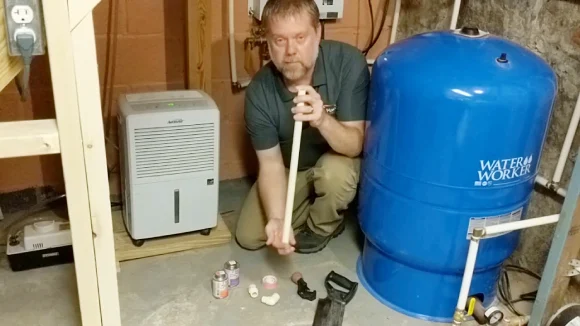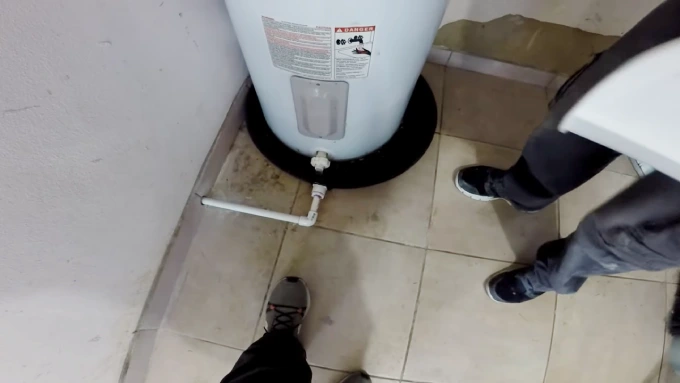Last Updated on May 6, 2023
Is draining the pressurized discharge from your water heater’s pressure relief valve into a pan a safe practice? Well, the short answer is no. When the valve discharges, it releases a significant amount of fluid under high pressure, making it impossible to drain it into a regular pan.
The last thing you want is to compromise your safety and risk dangerous situations like explosions. The pressure relief valve plays a critical role in maintaining the safety and longevity of your water heater. For this reason, you must install an appropriate drain system large enough to contain all the valve’s discharge.
Here, we’ll pull the curtain back and provide you with what really matters to ensure your water heater operates securely and proficiently. Dive into this post for all of the crucial info.
Why Shouldn’t a Pressure Relief Valve Drain into a Pan?

Pressure Relief Valves (PRVs) play a vital role in keeping pressurized systems, such as water heaters, safe. These valves release any excess pressure that builds up in the system, thereby preventing catastrophic accidents.
However, problems can arise if the discharge process is not handled correctly, especially when it involves draining into a pan. Here are reasons why you shouldn’t drain a Pressure Relief Valve into a pan:
#1: PSV Discharge Pressure Drop
Although a drain pan may seem like a logical solution for collecting discharged fluid from the PRV, it can create serious problems. The PSV discharge pressure drop is a significant issue, causing valve operation problems.
Additionally, when fluid is caught in a pan, it increases the pressure drop even further. The discharge pressure drop caused by a PRV can significantly affect the valve’s operation, especially in two-phase flow.
#2: Termination of Drain Pan
The above statement states that direct connections to drainage systems are not recommended for a water heater pan. Instead, the pan should end at a suitable indirect waste receptor, floor drain, or exterior.
However, these options require an air gap to prevent backflow, making it dangerous to drain PRV discharge into them. Further, the pan isn’t designed for high-pressure PRV discharge, and the indirect waste receptor/floor drain isn’t either.
#3: Size of Drain Outlet in Drain Pan
When your water heater system experiences leaks, the drain pan is designed to catch the discharged fluid. Although, it isn’t suitable for handling high-pressure PRV discharge because it has a limited diameter drain outlet.
This outlet can’t handle the PRV discharge at full flow, leading to a slower draining process. This slower draining process is problematic because the PRV water won’t drain quickly enough, causing the pan to overflow. Ultimately, this defeats the purpose of the pan.
What can be used to drain a PRV Instead of a pan?

Draining a PRV is an important task, but not one that’s without its mess. Using a pan to collect the water can result in spillage on the floor, so we suggest using a bucket instead. This simple alternative option will keep things tidy and ensure no water ends up where it shouldn’t.
Not only will it prevent any potential spillage, but it also helps ensure that the drainage runs smoothly. It is recommended to use a minimum of five-gallon buckets to prevent overfilling. Plus, ensure that the discharge pipe is placed 4″-6″ above the top of the container for an efficient draining process.
Also, creating an air gap by leaving a 1.5-inch rim below the container ensures everything runs correctly. However, for large-scale PRV drainages, industry-specific approaches like containment apparatus can be explored to optimize the process.
Where should the pressure relief valve drain to?
The pressure relief valve must be connected to a proper discharge pipe that directs the hot water released from the valve to a safe location. The temperature relief valve should discharge to the floor, drain, or outside the building for a water heater application.
The discharge pipe must be made of an approved material, free of any valves or tee-fittings that could impede the flow. Moreover, the pipe outlet must not be obstructed and should terminate within a range of 2-6 inches above the floor or waste receptor such as a floor drain.
Ensuring that the TPR valve operates correctly and activates if either water temperature or pressure exceeds safe levels is critical.
How much water should come out of the pressure relief valve while draining?

A pressure relief valve’s ideal “blowdown” can range between 2 and 20% which is not set firmly in stone. Depending on the water heater’s size, pressure rating, temperatures, and local codes & regulations, this measure may differ accordingly.
To maintain optimal efficiency and safety, regularly check that your water heater’s pressure stays within the recommended range. If it reaches its limit, a relief valve will activate to prevent hazards caused by an excessive buildup of pressure, thus allowing you to keep enjoying all of its benefits as intended.
Note: The threat of overflowing water is far too great to drain it into a pan simply. Installing a proper pipe system will safely channel excess liquid away from the area, creating invaluable peace of mind.
How often should you check PRV drain lines?
As a best practice, inspecting and maintaining your PRV valve’s drain line every 5 to 6 months is recommended. This regular interval allows you to proactively identify potential issues and take necessary corrective actions before problems escalate.
During these inspections, you should particularly be on the lookout for the following problems:
1. Blockages: Sediment, debris, or mineral buildup can accumulate in the drain line over time, causing blockages that prevent the safe discharge of excess water. Regularly checking the drain line will help you detect and remove any developing blockages to prevent disruptions to your plumbing system.
2. Corrosion: Metal drain lines can corrode over time, which can weaken the pipe and cause it to leak or rupture. Inspecting for signs of corrosion every 5 to 6 months will help you identify and address any issues before they become more severe and costly to repair.
3. Leaks: Leaks in the drain line can cause water damage to your property and lead to mold and mildew growth. By performing regular inspections, you spot any leaks early and take appropriate measures to repair or replace the affected section of the drain line.
4. Proper Discharge Location: It is essential to verify that the PRV valve’s drain line is discharging water safely and correctly, away from any foundation, electrical components, or areas that could be negatively affected by excess water. You can make any necessary adjustments by regularly checking to ensure this is the case.
5. Damage to the Valve: In some cases, the PRV valve itself may malfunction and require repair or replacement. Inspecting the drain line regularly will enable you to gauge the performance of the TRV valve and address any issues that may arise promptly.
Can you discharge a PRV into a waste pipe instead of a pan?

There’s a better way to discharge a Pressure Relief Valve (PRV) than the traditional method of using a pan. Connecting the PRV discharge piping directly to the waste pipe can simplify your system and improve overall performance.
This is particularly useful for boilers where space is at a premium and the risk of leaks or spills is a concern. You can save space and reduce the risk of accidents by eliminating the need for a separate drip pan or collection vessel.
Also, if you connect the condensate drain to the waste pipe below the tundish, you create a one-pipe solution that further simplifies the system. Therefore, consider this practical solution if you’re looking for a convenient and efficient way to discharge your PRV.
Are pressure relief valves allowed to drain into condensate drains?
A pressure relief safety valve can technically drain into the condensate drain, but it is not always recommended or considered the best practice. The primary purpose of pressure relief valves is to release excess pressure within a system, such as a boiler, water heater, or HVAC system, to prevent structural damage or potential hazards.
The condensate drain line is designed to remove and dispose of the condensation produced in the storage tank by the system during its normal operation. Mixing these two discharges may result in various issues depending on the system design and local regulations.
Guard Against Unsafe Draining: Don’t Let Discharge Go in the Pan
When dealing with the pressurized discharge of a relief valve, it’s crucial to proceed with caution. Many might think draining the discharge into a pan is alright, but that’s not the case. It’s way too small to handle the full discharge, so you and others are at risk of getting hurt.
Instead, installing an adequate indirect waste receptor specially designed for such discharges is best. By taking this safety measure, you can prevent potential damage to your home and the surrounding area.
We hope this informative blog has shed some light on the critical role of proper pressure relief valve discharge handling. Remember to prioritize your safety and always seek professional help whenever necessary.


